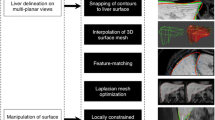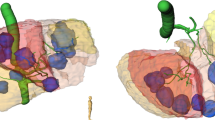Abstract
Purpose
Multimodality registration of liver CT and MRI scans is challenging due to large initial misalignment, non-uniform MR signal intensity in the liver parenchyma, incomplete liver shapes in Open-MR scans and non-rigid deformations of the organ. An automated method was developed to register liver CT and open-MRI scans.
Methods
A hybrid registration algorithm was developed which incorporates both rigid and non-rigid methods. First, large misalignment of input CT and Open-MR images was compensated by intensity-based registration. Maximum intensity projections (MIPs) of CT and MR data were registered in 2D, and the corresponding rigid transform parameters were used to align 3D images in axial, coronal and sagittal planes. Use of MIP projections compensates for intensity inhomogeneities inherent in the Open-MR data. A bounding box of MIP images defines an ROI which removes outliers and copes with incomplete MR data. Next, principal components analysis (PCA) was used to align MR and CT data datasets. The corresponding translation and rotation parameters were then used to increase the global registration accuracy. A modified TPS-RPM point-based non-rigid algorithm was used to accommodate local liver deformations. Surface points on the liver and branching points of the portal veins were input as landmarks to TPS-RPM method. Incorporating vascular branching points improves registration since tumors are usually found near vessels, so greater weight was given to branching points compared with surface points.
Results
The automated registration algorithm was compared with both rigid and non-rigid methods. Quantitative evaluation was performed using modified Hausdorff distance and overlap measure. The mean modified Hausdorff distances of liver and tumor were decreased from 23.53 and 40.03 mm to 9.38 and 8.88 mm, respectively. The mean overlap measures of liver and tumor were increased from 39 and 0 % to 78 and 27 %, respectively. Statistical analysis of the outcomes resulted in a p value less than 5 %.
Conclusion
MIP-PCA-based rigid multimodality CT–MRI registration of liver scans compensates for large misalignment of input images even when the data are incomplete. A modified TPS-RPM algorithm, in which vascular points are emphasized over surface points, successfully handled local deformations.















Similar content being viewed by others
References
Grey ML, Ailinani JM (2003) CT & MRI pathology: a pocket atlas. McGraw-Hill Medical, New York
Morikawa S, Inubushi T, Kurumi Y, Naka S, Sato K, Demura K, Tani T, Haque HA, Tokuda J, Hata N (2003) Advanced computer assistance for magnetic resonance-guided microwave thermocoagulation of liver tumors. Acad Radiol 10(12):1442–1449
Nakayama Y, Li Q, Katsuragawa S, Ikeda R, Hiai Y, Awai K, Kusunoki S, Yamashita Y, Okajima H, Inomata Y, Doi K (2006) Automated hepatic volumetry for living related liver transplantation at multisection CT. Radiology 240(3):743-748
Selle D, Preim B, Schenk A, Peitgen HO (2002) Analysis of vasculature for liver surgical planning. IEEE Trans Med Imaging 21(11):1344–1357
Meinzer HP, Schemmer P, Schöbinger M, Nolden M, Heimann T, Yalcin B, Richte GM, Kraus T, Buchler MW, Thorn M (2004) Computer-based surgery planning for living liver donation. In: 20th ISPRS Congress, Istanbul, pp 291–295
Huang X, Wang B, Liu R, Wang X, Wu Z (2008) CT-MR image registration in liver treatment by maximization of mutual information. In: IEEE international symposium onIT in medicine and education, 2008. ITME 2008. pp 715–718
Orchard J (2007) Efficient least squares multimodal registration with a globally exhaustive alignment search. IEEE Trans Image Process 16(10):2526–2534
Zhu YM (2012) Volume sweeping and bodyline matching for automated prealignment in volumetric medical image registration. Comput Biol Med 42(11):1043–1052
Tang S, Wang Y (2010) MR-guided liver cancer surgery by nonrigid registration. In: 2010 international conference on medical image analysis and clinical applications (MIACA). pp 113–117
Lee D, Nam WH, Lee JY, Ra JB (2011) Non-rigid registration between 3D ultrasound and CT images of the liver based on intensity and gradient information. Phys Med Biol 56(1):117
Gering DT, Nabavi A, Kikinis R, Hata N, O’Donnell LJ, Grimson WEL, Jolesz FA, Black PM, Wells WM (2001) An integrated visualization system for surgical planning and guidance using image fusion and an open MR. J Magn Reson Imaging 13(6):967–975
Rieder C, Wirtz S, Strehlow J, Zidowitz S, Bruners P, Isfort P, Mahnken AH, Peitgen HO (2012) Automatic alignment of pre-and post-interventional liver CT images for assessment of radiofrequency ablation. In: SPIE Medical Imaging, international society for optics and photonics SPIE medical imaging. p 83163E
Zhang X, Fujita H, Qin T, Zhao J, Kanematsu M, Hara T, Zhou X, Yokoyama R, Kondo H, Hoshi H (2008) CAD on liver using CT and MRI. In: Medical imaging and informatics. Springer, Berlin, pp 367–376
Alpert NM, Bradshaw JF, Kennedy D, Correia JA (1990) The principal axes transformation —a method for image registration. J Nucl Med 31:1717–1723
Fernandez-de-Manuel L, Wollny G, Kybic J, Jimenez-Carretero D, Tellado JM, Ramon E, Desco M, Santos A, Pascau J, Ledesma-Carbayo MJ (2014) Organ-focused mutual information for nonrigid multimodal registration of liver CT and Gd-EOB-DTPA-enhanced MRI. Med Image Anal 18(1):22–35
Song H, Li JJ, Wang SL, Ma JT (2014) Multi-modality liver image registration based on multilevel B-splines free-form deformation and L-BFGS optimal algorithm. J Cent South Univ 21:287–292
Passera K, Selvaggi S, Scaramuzza D, Garbagnati F, Vergnaghi D, Mainardi L (2013) Radiofrequency ablation of liver tumors: quantitative assessment of tumor coverage through CT image processing. BMC Med Imaging 13(1):3
Chen YW, Xu R, Tang SY, Morikawa S, Kurumi Y (2007) Non-rigid MR-CT image registration for MR-guided liver cancer surgery. In: IEEE/ICME international conference on complex medical engineering, 2007. CME 2007. pp 1756–1760
Chui H, Rangarajan A (2003) A new point matching algorithm for non-rigid registration. Computer Vision and Image Understanding 89(2):114–141
Foruzan AH, Yen-Wei CHEN, Zoroofi RA, Furukawa A, Masatoshi HORI, Tomiyama N (2013) Segmentation of liver in low-contrast images using K-means clustering and geodesic active contour algorithms. IEICE Trans Inf Syst 96(4):798–807
Smith LI (2002) A tutorial on principal components analysis, vol 51. Cornell University, USA
Lorensen WE, Cline HE (1987) Marching cubes: a high resolution 3D surface construction algorithm. In: ACM siggraph computer graphics, vol 21, No 4, pp 163–169. ACM
Garland M, Heckbert PS (1997) Surface simplification using quadric error metrics. In: Proceedings of the 24th annual conference on computer graphics and interactive techniques, pp 209–216. ACM Press/Addison-Wesley Publishing Co
Frangi AF, Niessen WJ, Vincken KL, Viergever MA (1998) Multiscale vessel enhancement filtering. In: Medical image computing and computer-assisted interventation—MICCAI’98. Springer, Berlin, pp 130–137
Lee TC, Kashyap RL, Chu CN (1994) Building skeleton models via 3-D medial surface axis thinning algorithms. CVGIP Graph Models Image Process 56(6):462–478
Available: http://www.ITKSnap.org. Accessed: 30 May, 2014
3D Slicer. http://www.Slicer.org/. Accessed: 20 March 2014
Dubuisson MP, Jain AK (1994) A modified Hausdorff distance for object matching. In: Proceedings of the 12th IAPR international conference on pattern recognition, vol 1-conference A: computer vision and image processing, vol. 1, pp 566–568
Niculescu G, Foran DJ, Nosher J (2007) Non-rigid registration of the liver in consecutive CT studies for assessment of tumor response to radiofrequency ablation. In: 29th Annual international conference of the IEEE, engineering in medicine and biology society, 2007. EMBS 2007. pp 856–859
Besl PJ, McKay ND (1992) Method for registration of 3-D shapes. In: Robotics-DL tentative. International society for optics and photonics, pp 586–606
Insight toolkit. http://www.ITK.org/. Accessed: 20 March 2014
Acknowledgments
The authors would like to thank Prof. Yen-Wei Chen, Ritsumeikan University, Shiga, Japan, and Prof. Yoshinobu Sato and Prof. Masatoshi Hori, Osaka University, Osaka, Japan, for the use of their images in this study.
Conflict of interest
Amir Hossein Foruzan and Hossein Rajabzadeh Motlagh declare that they have no conflict of interest.
Author information
Authors and Affiliations
Corresponding author
Electronic supplementary material
Below is the link to the electronic supplementary material.
Rights and permissions
About this article
Cite this article
Foruzan, A.H., Motlagh, H.R. Multimodality liver registration of Open-MR and CT scans. Int J CARS 10, 1253–1267 (2015). https://doi.org/10.1007/s11548-014-1139-0
Received:
Accepted:
Published:
Issue Date:
DOI: https://doi.org/10.1007/s11548-014-1139-0




